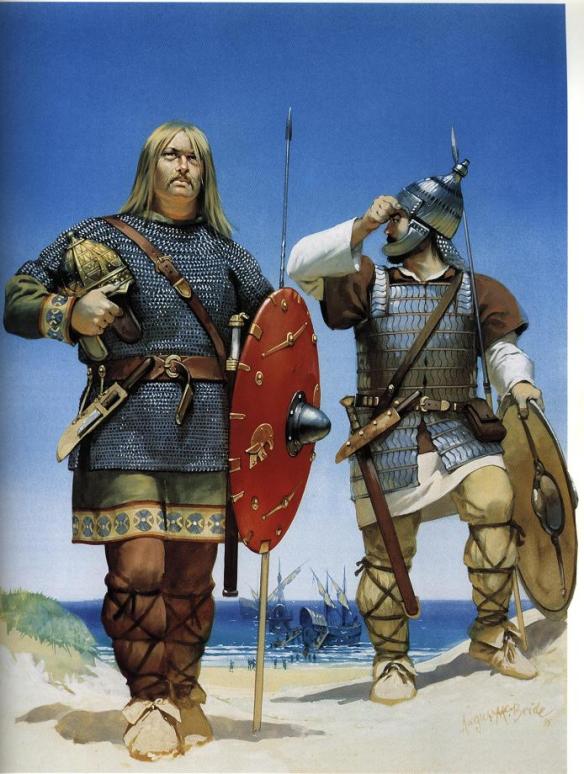Artist conception of Vandal and Alan warriors in North Africa.
The western Mediterranean, remote as it was from the areas of barbarian activity, enjoyed relative freedom from their depredations. That freedom was interrupted in AD 258; a large number of Frankish tribesmen had crossed the Rhine and avoiding the frontier defences, they then proceeded to pillage their way across Gaul and Spain to Tarragona which they sacked. That they were able to do this was a consequence of the defensive system which concentrated military strength on the borders; once past them, there was little to interfere with the Frank’s progress. The nearest legions were stationed in north-west Spain and North Africa. In Spain, the Franks seized a number of merchant ships (presumably with their sailors) and sailed for Africa where, after some raiding, they were repulsed. They may have been operating as pirates from Spain for some years in fact and their ultimate fate is unknown.
Twenty years later, an experiment to resettle large number of captured Franks in Pontus went disastrously wrong. As has been seen, these coasts were already suffering barbarian raids and in AD 279, taking advantage of the distraction caused by a civil war, the Franks rebelled, seized as many ships as they could and set off on an epic voyage of piracy. They sailed into the Aegean, attacked Cyrene (eastern Libya) then Sicily, where they sacked an unsuspecting Syracuse. From there, they crossed to Tunisia, where they were driven off by local forces. The voyage continued on, into the Atlantic and they rounded the coasts of Spain and Gaul to return to their homeland. This was an amazing feat of seamanship and significant in that at no time were they challenged by Roman naval forces, indicating perhaps how far the latter had deteriorated. It is not known how many Franks set out, or how many ships they had, or ultimately how many survived the voyage.
In the winter of AD 406 the Rhine froze solid, preventing Roman river patrols and permitting a mass crossing by tens of thousands of Vandals, Alans and Suevi. They rampaged across Gaul and in AD 409, crossed into Spain. The Vandals, doubtless joined by other tribesmen and various malcontents from Gaul and Spain, ranged over and plundered Spain for some twenty years. It seems likely that opposition built and they moved to southern Spain, there, they started to acquire some ships and raid the African coast and Balearic Islands. Finally in AD 429 they crossed to Africa en masse and for the next ten years, gradually made their disruptive way eastward across North Africa. They were at last opposed by a Roman army of between ten and twenty thousand men at Carthage, commanded by the count of Africa, Boniface. Incredibly, Boniface crossed to Italy with the army seeking power, leaving Carthage virtually undefended. The Vandals took Carthage in AD 439, completeing their occupation of northern Tunisia and setting up their kingdom there. With Carthage, they acquired a fleet, shipyards and the people to build ships, as well as experienced crews.
For the first time in over six centuries, there was a navy in the central Mediterranean other than Roman. The Vandals proceeded to build up a fleet of some 120 warships and with them, went on to occupy much of Sicily, Sardinia and Corsica by AD 440. The eastern emperor sent a hastily formed naval expedition against them which failed. Other diversions meant that the Empire could not focus on the Vandals who, in AD 455 sailed to Ostia and attacked and sacked Rome. A Roman fleet from Italy did take the offensive and beat the Vandal fleet off Corsica in AD 456. The Vandal advance in Sicily was halted and their fleet again beaten off Agrigento. In the following year (AD 457) the Vandal fleet was ejected from Ostia and the mouth of the Tiber.
In AD 460 the western emperor Majorian (reigned AD 457–461) was fitting out a fleet in Cartagena of some 300 ships but the Vandals learned of it and in a surprise attack, destroyed the fleet before it was ready and able to sail. The Vandals went on to raid the Peloponnese in AD 467, provoking the eastern emperor Leo (reigned AD 457–474) to action. The eastern half of the Empire had a large fleet and this escorted a huge army intended to eliminate the Vandal kingdom. The western emperor Anthemius (reigned AD 467–472) sent forces and his fleet, which had in the meantime, driven the Vandals from Sardinia. The whole force was commanded by Leo’s brother-in-law Basiliscus. To attack Carthage he chose to make his landing in the Bay of Tunis against the west face of Cape Bon (Hermaeum) a rocky, lee shore. In both previous Roman invasions of Carthage, in the Second and Third Punic Wars, they had landed and made their base to the west of Carthage, and thus always had the weather gauge in subsequent operations against the city. Instead of attacking at once, when his forces would have swept all before them, he delayed. This gave the Vandals time to prepare and five days later the wind went round to the west, holding the Roman fleet against the shore and enabling the Vandal fleet, with the wind behind them, to attack with fireships and the ram. The closely packed and anchored Roman ships had no room to manoeuvre and half of their ships were destroyed, the rest escaped to Sicily, abandoning the campaign. This was the last operation of a fleet of the Western Roman Empire, the fleet of the eastern Empire did continue in existence to be what we now, for convenience, refer to as Byzantine.
